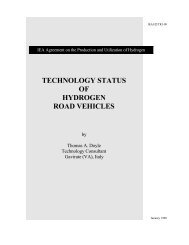Edited by Mary Rose de Valladares M.R.S. Enterprises, LLC ...
Edited by Mary Rose de Valladares M.R.S. Enterprises, LLC ...
Edited by Mary Rose de Valladares M.R.S. Enterprises, LLC ...
You also want an ePaper? Increase the reach of your titles
YUMPU automatically turns print PDFs into web optimized ePapers that Google loves.
un<strong>de</strong>rstanding photosynthetic mecha<br />
nism in relation to hydrogen production<br />
and the trial to improve the photosyn<br />
to challenge. These objectives require<br />
the application of mo<strong>de</strong>rn and advanced<br />
tools of molecular biotechnology and<br />
microbial physiology, techniques already<br />
available at leading research laborato<br />
ries in the participating countries.<br />
Subtask B will focus on:<br />
1. Genetics and Metabolism of H 2<br />
production <strong>by</strong> photosynthetic microbes.<br />
2. Physiology and cultivations of<br />
photosynthetic microbes to maximize<br />
H2 production from water or organic<br />
wastes.<br />
3. Photosynthesis overcoming<br />
limiting factors.<br />
Goal: I<strong>de</strong>ntify promising<br />
applications of enzymes and<br />
biologicallyinspired processes for<br />
hydrogen production and fuel cells<br />
Hydrogen production <strong>by</strong> in vitro and<br />
bioinspired systems and construction of<br />
biological fuel cells are a most mo<strong>de</strong>rn<br />
part of nanotechnology and molecular<br />
handling technology. In the bioinspired<br />
systems for hydrogen production, photo<br />
synthetic apparatus from cyanobacteria,<br />
algae or photosynthetic bacteria and hy<br />
drogenase enzymes from various kinds<br />
reconstituted in the consi<strong>de</strong>ration for<br />
effective electron transportation among<br />
the components. These technologies<br />
can resolve the problematic limit in the<br />
R & D for biological fuel cell systems is<br />
environmentally acceptable technology<br />
because of no use of much rare metals.<br />
Subtask C will focus on:<br />
1. Enzyme systems for hydrogen<br />
production.<br />
2. Bioinspired systems for hydro<br />
gen production.<br />
3. Biological fuel cells coupling<br />
enzymes and even whole organisms to<br />
electro<strong>de</strong>s.<br />
Goal: Finding the solution to<br />
realize the biohydrogen process<br />
in the coming hydrogen society.<br />
Adaptation of the technology is<br />
analyzed from the economical,<br />
technological and socialistic point<br />
of view.<br />
Attention to renewable energy<br />
technologies like BioHydrogen has been<br />
increasing not only due to its environ<br />
mentally acceptable characteristics, but<br />
also due to the recent rise in the price<br />
of oil. BioHydrogen has quite different<br />
characteristics from energy systems<br />
based on fossil fuels; BioHydrogen en<br />
ergy sources, sunlight and biomass, are<br />
found around the world. Therefore, we<br />
have to evaluate this technology from<br />
both sociological and economical points<br />
of view. The effects of BioHydrogen on<br />
social systems and human life are to be<br />
evaluated. Analysis of unstable factors<br />
(i.e. availability of sunlight and biomass)<br />
manipulated microorganisms) should be<br />
studied. Other important subjects are<br />
economic analysis and social accep<br />
tance.<br />
Subtask D will focus on:<br />
1. Effects of BioHydrogen on social<br />
systems and human life<br />
2. Analysis of unstable factors and<br />
risks of BioHydrogen<br />
3. Economic and social conditions<br />
nee<strong>de</strong>d to realize BioHydrogen.<br />
DURATION<br />
program was proposed. The task 21 is<br />
scheduled for a threeyear period, with<br />
an option for a 2year extension. The<br />
task 21 was proposed and tentatively<br />
approved at 52th ExCo meeting in<br />
Norway, May 9, 2005. Then, the pro<br />
posal revised in the kickoff meeting <strong>by</strong><br />
expert of Task 21 in IHEC 2005 (Inter<br />
31<br />
“BioHydrogen<br />
has different<br />
characteristics<br />
from energy systems<br />
based on fossil fuels;<br />
BioHydrogen energy<br />
sources, sunlight<br />
and biomass, are<br />
found around the<br />
world. Therefore,<br />
we evaluate this<br />
technology from<br />
both sociological<br />
and economical<br />
points of view.”













